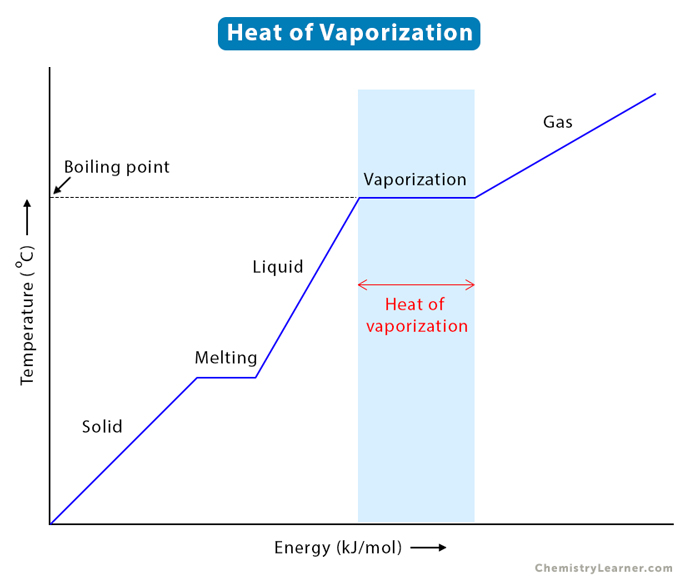Heat of Vaporization
The heat of vaporization is the enthalpy change when a unit mass of a substance changes its state from liquid to gas at a constant temperature and pressure. It is sometimes called enthalpy of vaporization or latent heat of vaporization. The process of going from liquid to gas is known as boiling, and the temperature at which it occurs is called the boiling point [1-4].
Vaporization is an endothermic process since heat is added to a substance. A well-known example of vaporization is water boiling into steam, a process applied in steam engines.
Molecular Explanation
During vaporization, the bonds connecting the atoms or molecules break down completely. The weaker the bond between the molecules, the less energy is needed to break those bonds. The attractive intermolecular forces disappear as the gas forms. The molecules then move freely with ample space.
Equation
Consider m grams of a liquid that requires q Joules of energy to change its state completely from liquid to gas. Then, the heat of vaporization (ΔHvap) is given by the following formula.
ΔHvap = q/m
Symbol: ΔHvap
Unit: Joules/gram (J/g), kiloJoules/kilogram (kJ/kg), or calories/gram (cal/g)
Note that ΔHvap > 0.
Molar Heat of Vaporization
The change in enthalpy when one mole of a substance undergoes a phase change from liquid to gas is called the molar heat of vaporization or molar enthalpy of vaporization. The molar heat of vaporization for water is 40.67 kJ/mol [1-4].
H2O (l, water) → H2O (g, water vapor) ΔHvap= 40.67 kJ/mol
The following table gives the ratio of the molar heat of vaporization to the boiling point of various substances [1].
| Substance | Formula | Boiling Point, Tb (K) | Molar Heat of Vaporization/Boiling Point, ΔHvap/Tb (J·mol-1·K-1) |
|---|---|---|---|
| Neon | Ne | 27 | 67 |
| Oxygen | O2 | 90.2 | 76 |
| Methane | CH4 | 112 | 73 |
| Ethane | C2H6 | 184 | 80 |
| Chlorine | Cl2 | 239 | 85 |
| Carbon tetrachloride | CCl4 | 350 | 86 |
| Water | H2O | 373.15 | 109 |
| n-Nonane | C9H20 | 491 | 82 |
| Mercury | Hg | 630 | 91 |
| Sodium | Na | 1158 | 85 |
| Lead | Pb | 2022 | 88 |
| Aluminum | Al | 2600 | 109 |
Heat of Condensation
The opposite of boiling is condensation. Heat is extracted from the gas to convert it into a liquid. The molecules come closer and are feebly attracted. The heat liberated by a unit mass of a substance is called heat (enthalpy) of condensation.
The amount of heat released when a unit mass of a substance transforms from gas to liquid is called the heat of condensation. Since vaporization and condensation are the exact opposite processes, the numerical value of the heat of vaporization is the same as that of condensation but opposite in sign.
ΔHcon = – ΔHvap
It is an exothermic process that explains the negative value.
Solved Problems
Problem 1: If the heat of vaporization for H20 is 2357 J/g, calculate the overall heat energy required to vaporize 100 grams of H20.
To calculate the heat (q) required to boil m grams of a liquid, we use the following formula:
q = m ΔHvap
Given, m = 100 g and ΔHvap = 2357 J/g
q = 100 g x 2357 J/g = 23570 J or 23.6 kJ
Problem 2: If a liquid uses 50 Joules of heat to vaporize 100 grams of liquid, then what would be the enthalpy of vaporization?
Solution
We use the following formula:
ΔHvap = q/m
Given, q = 50 J and m = 100 g
Therefore, ΔHvap = q/m = 50 J/ 100 g = 0.5 J/g





